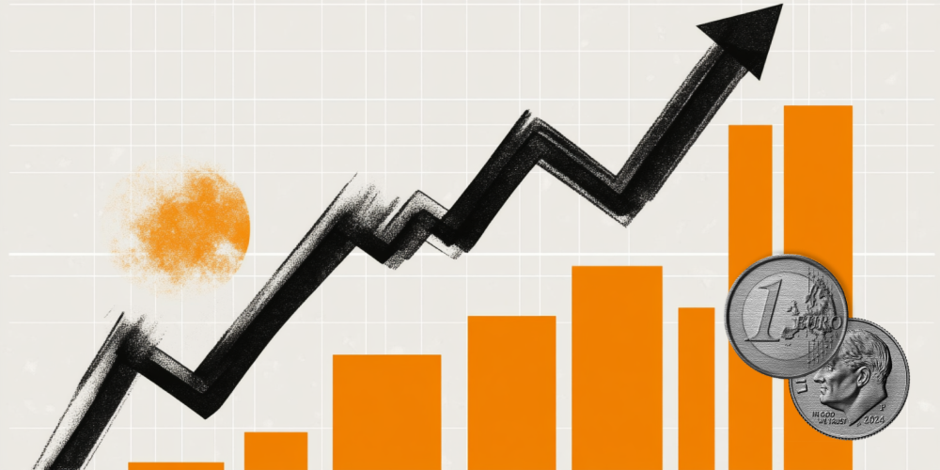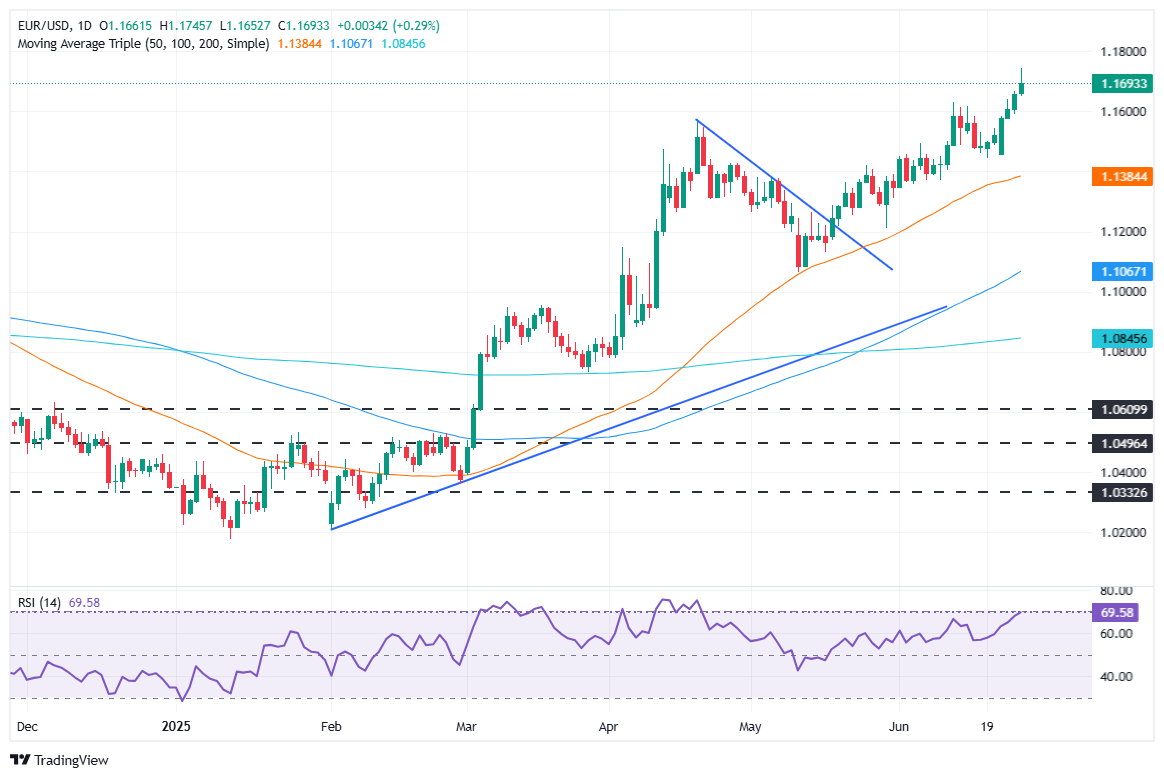Created
: 2025.06.27














![]() 2025.06.27 07:40
2025.06.27 07:40
EUR/USD soars to nearly four-year highs on Thursday, extending its rally to five straight days, with the pair clearing the 1.1700 figure for the first time since September 2021. Expectations that the Federal Reserve (Fed) would lower rates sooner than expected pushed the major to yearly highs of 1.1744, before retreating to 1.1697, up 0.33%.
The US Dollar remains pressured due to news related to the Fed, as a Wall Street Journal (WSJ) article revealed that US President Donald Trump is considering nominating some of his advocates to be the next Fed Chair, replacing Jerome Powell, whose term ends in May 2026.
The idea surfaced as Trump's ire towards Powell's reluctance to cut rates could prompt an earlier announcement during the summer.
The US economic docket revealed a tranche of data. Initial Jobless Claims came in below estimates, while Durable Goods Orders in May soared. However, the economy contracted as expected, as the Gross Domestic Product (GDP) missed estimates.
Boston Fed President Susan Collins added to the hawkish chorus, saying that not enough data was available in July to determine whether to cut rates. Richmond Fed Thomas Barkin added his name to the list, saying that Fed policy is well positioned, as inflation would rise due to tariffs imposed by the Trump administration.
Across the pond, ECB Luis de Guindos said that future policy decisions will be guided by evolving trade dynamics, opening the door for additional rate cuts.
The EUR/USD uptrend remained intact on Thursday, after clearing key resistance at 1.1700, but printed a daily close below this level. The Relative Strength Index (RSI) is approaching overbought territory, but due to the strength of the trend, the most extreme reading is currently at 80.
Failure to achieve a daily close above 1.1700 opened the door for an EUR/USD pullback. The first support would be the June 12 high of 1.1631, followed by 1.1600. A breach of the latter will expose the 20-day SMA at 1.1514. Conversely, if EUR/USD climbs past 1.1700, the first resistance would be a multi-year peak at 1.1744. Once surpassed, the next area of demand would be 1.1800.

The Euro is the currency for the 19 European Union countries that belong to the Eurozone. It is the second most heavily traded currency in the world behind the US Dollar. In 2022, it accounted for 31% of all foreign exchange transactions, with an average daily turnover of over $2.2 trillion a day. EUR/USD is the most heavily traded currency pair in the world, accounting for an estimated 30% off all transactions, followed by EUR/JPY (4%), EUR/GBP (3%) and EUR/AUD (2%).
The European Central Bank (ECB) in Frankfurt, Germany, is the reserve bank for the Eurozone. The ECB sets interest rates and manages monetary policy. The ECB's primary mandate is to maintain price stability, which means either controlling inflation or stimulating growth. Its primary tool is the raising or lowering of interest rates. Relatively high interest rates - or the expectation of higher rates - will usually benefit the Euro and vice versa. The ECB Governing Council makes monetary policy decisions at meetings held eight times a year. Decisions are made by heads of the Eurozone national banks and six permanent members, including the President of the ECB, Christine Lagarde.
Eurozone inflation data, measured by the Harmonized Index of Consumer Prices (HICP), is an important econometric for the Euro. If inflation rises more than expected, especially if above the ECB's 2% target, it obliges the ECB to raise interest rates to bring it back under control. Relatively high interest rates compared to its counterparts will usually benefit the Euro, as it makes the region more attractive as a place for global investors to park their money.
Data releases gauge the health of the economy and can impact on the Euro. Indicators such as GDP, Manufacturing and Services PMIs, employment, and consumer sentiment surveys can all influence the direction of the single currency. A strong economy is good for the Euro. Not only does it attract more foreign investment but it may encourage the ECB to put up interest rates, which will directly strengthen the Euro. Otherwise, if economic data is weak, the Euro is likely to fall. Economic data for the four largest economies in the euro area (Germany, France, Italy and Spain) are especially significant, as they account for 75% of the Eurozone's economy.
Another significant data release for the Euro is the Trade Balance. This indicator measures the difference between what a country earns from its exports and what it spends on imports over a given period. If a country produces highly sought after exports then its currency will gain in value purely from the extra demand created from foreign buyers seeking to purchase these goods. Therefore, a positive net Trade Balance strengthens a currency and vice versa for a negative balance.
![]()
Created
: 2025.06.27
![]()
Last updated
: 2025.06.27

FXStreet is a forex information website, delivering market analysis and news articles 24/7.
It features a number of articles contributed by well-known analysts, in addition to the ones by its editorial team.
Founded in 2000 by Francesc Riverola, a Spanish economist, it has grown to become a world-renowned information website.
We hope you find this article useful. Any comments or suggestions will be greatly appreciated.
We are also looking for writers with extensive experience in forex and crypto to join us.
please contact us at [email protected].
Disclaimer:
All information and content provided on this website is provided for informational purposes only and is not intended to solicit any investment. Although all efforts are made in order to ensure that the information is correct, no guarantee is provided for the accuracy of any content on this website. Any decision made shall be the responsibility of the investor and Myforex does not take any responsibility whatsoever regarding the use of any information provided herein.
The content provided on this website belongs to Myforex and, where stated, the relevant licensors. All rights are reserved by Myforex and the relevant licensors, and no content of this website, whether in full or in part, shall be copied or displayed elsewhere without the explicit written permission of the relevant copyright holder. If you wish to use any part of the content provided on this website, please ensure that you contact Myforex.
Myforex uses cookies to improve the convenience and functionality of this website. This website may include cookies not only by us but also by third parties (advertisers, log analysts, etc.) for the purpose of tracking the activities of users. Cookie policy